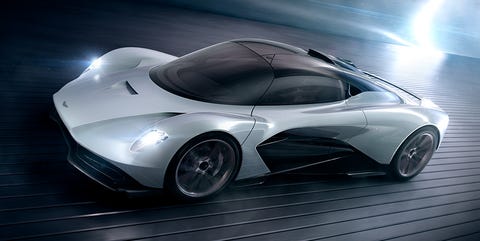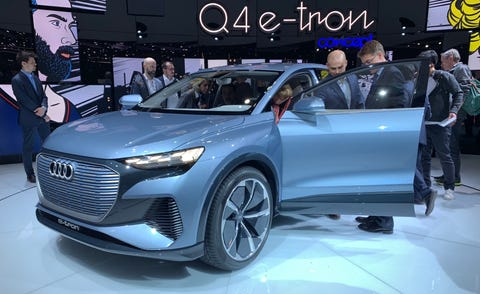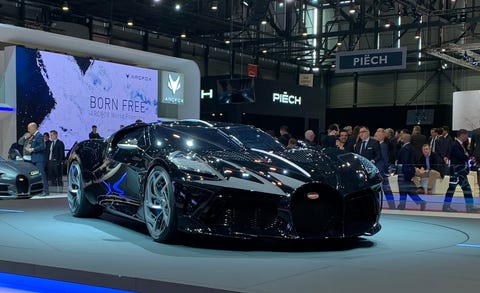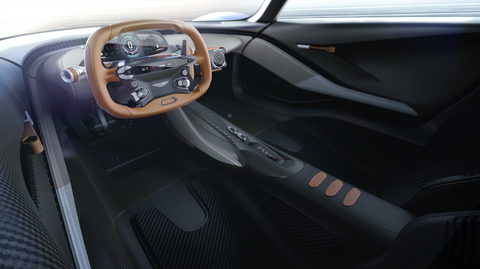The Ferrari P80/C Is a Track-Only Homage to 1960s Prototypes

Ferrari says that its latest one-off, the P80/C, took almost four years to develop, making this their longest special project to date. The work began in 2015, and for a client in love with the Ferrari prototypes of the 1960s, the base car had to be a 488 GT3.
The GT3 race car has a 2-inch longer wheelbase than a 488 GTB, which allowed for a more cab-forward design with a longer rear end. The tinted wraparound windscreen is straight off a racing helmet, while the shaved off highlights give the P80/C superior aerodynamic performance. As you would expect from a track weapon, the area under the massive rear wing is mostly exposed, in true prototype fashion.
Inspired by the likes of the 330 P3 and P4, the 350 Can Am, the Dino 206 SP and the stunning 250 LM, the P80/C was made entirely from carbon-fiber, finished in Rosso Vero, which is a bright red named by the client Ferrari refers to as “TK”. As you can probably tell, the P80/C was designed by Flavio Manzoni to be the brand’s ultimate modern prototype. So forget the FXX K Evo or the Monza SP1, and say hi to Ferrari’s fastest one-off yet.
By: Mate Petrany, March 25, 2019
For more cars, visit: https://www.roadandtrack.com/new-cars/future-cars/a26929748/ferrari-p80c-specs-info-gallery/
Source: https://www.roadandtrack.com/
Say Hello to the “Pearl of the Gulf” Bentley Bentayga
Aston Martin, Rolls-Royce, McLaren, Ferrari… and Bentley. All of them have special departments catering exclusively to the world’s super rich. If Sir or Madam would like something fitted to their car that isn’t on the options list, or for their car to be painted in a special colour, it’s these departments that handle the work. And charge handsomely for their time, naturally.
Bentley’s is called Mulliner, and this is its latest creation – a Bentayga five-off inspired by “the Arabian Gulf’s rich pearl diving heritage”. The Bentayga “Mulliner Pearl of the Gulf” W12 features white paint, a leather interior trimmed in “Brunel” and “Linen” hides and a Breitling clock with a mother-of-pearl dial. Contrast gold stitching and thick lambswool rugs complete the look.
The big thing, though, is a secure lockbox hidden in the centre console, complete with a fingerprint scanner. Bentley says the cubby is the “ideal place to stow valuables while at the beach or utilising valet parking services”. Right.
Mechanically, this is a regular W12-engined Bentayga – meaning 600bhp and 663lb ft from 12-cylinders and 6.0-litres, enabling an indecent 0-62mph of four seconds flat and a top speed of 187mph. Cost? If you have to ask…
By: Tom Harrison, March 20, 2019
For more cars, visit: https://www.topgear.com/car-news/suvs/say-hello-pearl-gulf-bentley-bentayga
Source: https://www.topgear.com/
2020 Porsche Cayenne Coupe First Look: Porsche Joins the Party

Argue over the semantics if you will, but four-door coupes are a thing. So, too, are four-door coupe SUVs. BMW offers the X6, X4, and X2; Mercedes-Benz has its GLE and GLC Coupes. Audi‘s flagship Q8 flirts with the format, as does the forthcoming electric-powered E-Tron Sportback. And now here’s Porsche arriving fashionably late to the party with the 2020 Cayenne Coupe, scheduled to go on sale in the U.S. this fall.
Porsche’s tardiness might seem surprising, given the company prides itself on building sport utility vehicles that are sportier than most. But the bean counters at Zuffenhausen dictated the Coupe variant had to wait until the development of the third-generation Cayenne, when the cost of unique panels and other hardware could be factored into the financials of the whole program.
And Porsche is expecting a big return on the investment: Insiders say the Coupe could account for up to 30 percent of global Cayenne volume. Although they acknowledge some cannibalization of existing Cayenne sales is inevitable, they also anticipate poaching a significant number of customers from BMW and Mercedes-Benz.
The Cayenne Coupe shares its basic structure and mechanical hardware with the regular Cayenne. Two versions of the Coupe will be available at launch: the entry-level model powered by the 335-hp, 332-lb-ft single turbo V-6; and the Cayenne Turbo Coupe, which has a 541-hp, 567-lb-ft variant of Porsche’s versatile 4.0-liter twin-turbo V-8 under the hood. The V-6 Coupe will start at $76,550, the Turbo Coupe at $131,350 (including $1,250 destination). That’s $9,600 and $5,500 more, respectively, than Porsche currently charges for its corresponding regular Cayennes, though that gap will likely narrow once pricing for the 2020 regular models is announced.
What does the extra money buy you? In terms of performance, nothing. Porsche claims the V-6 Coupe will hit 60 mph in 5.7 seconds and has a top speed of 151 mph, while the Turbo Coupe is good for a 0-60 mph time of 3.7 seconds and a top speed of 178 mph. In other words, they’re no quicker than regular Cayennes. What you’re paying for is a restyled Cayenne with some extra goodies. Both models come standard with Porsche’s Sport Chrono Package and a panorama sunroof, for example. The V-6 Coupe rolls on steel springs with PASM-controlled shocks and sports 20-inch wheels, while the Turbo Coupe comes with air suspension and 21-inch alloys; it also gets Porsche’s PSCB surface-coated brake package with its signature white calipers.
In terms of sheetmetal, the Coupe shares only its hood, front fenders, front door skins, and lights with the regular Cayenne. The A-pillars have been angled further back to deliver a faster windshield angle—the windshield itself is shallower—and the roofline has been lowered 0.8 inches. The cant rails arc gracefully rearward into 0.7-inch-wider rear quarter panels to create what design chief Michael Mauer calls the Porsche ‘flyline,’ providing the framing for a greenhouse graphic that overtly echoes that of the iconic 911. The rear backlight is steeply raked; the large rear hatch incorporates a fixed spoiler at its top edge and an active spoiler that nestles in the vestigial rump at the lower edge of the rear window. This lower spoiler deploys 5.3 inches into the airflow at speeds above 56 mph to improve stability.
The interior is virtually identical to that of the current Cayenne, which is no bad thing given its well-executed mix of technology, materials, and colorways. The Coupe comes standard in four-passenger trim, with two pseudo-bucket seats separated by a cubby and a large fold-down armrest. (A regular bench is available as a no-cost option.) The rear seat is mounted 1.2 inches lower than in the regular Cayenne to provide more headroom. This means 6-footers will fit, but the setup means the Coupe’s rear seat doesn’t slide fore/aft as it does in the regular Cayenne, as there’s no room for the mechanism underneath. The backrest can still be reclined, though.

The decision to make the panoramic glass roof standard on the Cayenne Coupe is more than just an amenity. Its dark coloring artfully disguises the fact the roofline doesn’t sweep down from the B-pillar as dramatically as the greenhouse suggests it does. Similarly, the carbon-fiber roof (part of the optional Lightweight Sports package) is left clear-coated, the side benefit of which, of course, is you can show your buddies what you spent the extra money on. The package saves about 48 pounds, most of it in the roof. It also includes weight-reduced 22-inch wheels; different side skirts, wheel-arch trim, exhausts, and front vent graphics; and sporty checked cloth seat inserts.
If you fervently believe form should follow function, the very idea of a four-door coupe SUV will make your head explode. However, as GM’s Alfred Sloan figured out almost 100 years ago, the secret to success in the auto business isn’t dictating to customers what they should drive, but creating something they want to drive. Porsche knows the 911 gets the glory, but it’s the Cayenne that makes the money. In that context, making a Cayenne look—squint hard—a little more like a 911 probably makes good business sense.
By: Angus MacKenzie, March 21, 2020
For more cars, visit: https://www.motortrend.com/cars/porsche/cayenne/2020/2020-porsche-cayenne-coupe-first-look-review/
Source: https://www.motortrend.com/
Porsche to Restart 911 GT2 RS Production After Cargo Ship Sinks With Cars On Board

A nightmare scenario has unfolded for several owners of the ultra-exclusive Porsche 911 GT2 RS after a cargo ship carrying their cars from the factory in Germany caught fire and sank off the coast of France last weekend, dooming the performance masterpieces to a watery grave. Now CarScoops reports Porsche will be restarting production of the GT2 RS, part of the previous 911 generation, to make the affected owners whole.
UPDATE: Porsche has confirmed to The Drive that four 911 GT2 RS models were aboard the Grande America, destined for buyers in Brazil, along with 33 other unspecified Porsches. The automaker also confirmed its plans to revive production of the car to remake those cars to the original order specifications. The full statement is below.
“Porsche Brasil confirms that 37 of its new cars, in route from Hamburg, Germany, to Santos, Brazil, were aboard the vessel Grande America that suffered a maritime incident near the coast of Brest, France, on March 12, 2019. Among the fleet were four 911 GT2RS units. In a special decision and to uphold its commitment to its valued Brazilian customers, Porsche has ensured that those units will be reproduced in the order in which they were originally confirmed.”
ORIGINAL STORY CONTINUES:
The already-rough year for car carriers on the high seas got even worse on March 12 when a fire broke out in a shipping container aboard the Italian-flagged Grande America, which was bringing around 2,000 brand-new Audis, a number of Porsche 911 GT2 RSs, and non-vehicular cargo to Brazil. Flames quickly overtook the ship, which began to list before capsizing and sinking a day later about 200 miles off the French Atlantic coast in 15,000 feet of water.
Fortunately, the BBC reports that all 27 mariners were rescued without incident. The same can’t be said for those $300,000 Porsches. It’s almost painful to look at pictures of the doomed ship, knowing that somewhere on board, the GT2 RS’s 700-horsepower twin-turbo flat-six engine is submitting to a silent death, never to scream down the Nurburgring en route to a lap record again.The GT2 RS stands as the ultimate expression of the 991 generation of 911, which wrapped up last year, and production of the GT2 RS itself finally wound down in February.
So does that mean these owners are straight out of luck? Typically, reviving an out-of-production car is next to impossible, given all the suppliers, factory lines, and product planning involved. But CarScoops obtained a letter from Porsche to one of the affected GT2 RS owners in Brazil that says the automaker will resume making the car next month to give them their rightful cars. It probably helps that these aren’t mass-market models.
“As you may know, Porsche ended the 991 GT2 RS production on February 2019 and under normal circumstances, it wouldn’t be possible to give you another car,” the letter reads in Portuguese. “But, due to the nature of the situation, and considering that you’re a loyal and highly valuable customer for our brand, Porsche has decided to resume the GT2 RS production in Germany, and your vehicle will be produced in April, with delivery scheduled for June.”
Historically, would-be owners of Porsche’s exclusive 911 GT cars have had to endure a minefield of long waitlists, exorbitant markups, and the occasional international criminal conspiracy to get their hands on Weissach’s fastest and finest. It looked as though we’d be adding shipwrecks to that list—not this time.
By: Kyle Cheromcha, March 19, 2019
For more cars, visit: https://www.thedrive.com/news/27035/porsche-to-restart-911-gt2-rs-production-after-cargo-ship-sinks-with-cars-on-board
Source: https://www.thedrive.com/
WEC Bullish Rules Change Will Attract Extra Manufacturer
Asked if the ACO expected real hypercars to be on the grid at the start of the 2020/21 season in 18 months’ time, sporting director Vincent Beaumesnil said: “Of course, otherwise we would not do it.”
He added: “If we are sticking to September 2020 [for the start of the new category], it is because we know some people will be ready to join us.
“We have expanded the regulations, because they were too restrictive.”
The ACO, which jointly writes the rules with the FIA, has not been drawn on which manufacturers might be on the grid next autumn, but it has confirmed that the three car makers who re-opened the debate on the regulations were Aston, McLaren and Ferrari.
Aston appears the most likely of those three to enter the top division of the WEC with a hypercar, while Toyota has stated that it could race a road-based car rather than a prototype.
WEC boss Gerard Neveu said that interest in the 2020/21 rules had increased since the announcement at the beginning of March that road-based machinery would be permitted.
“Last week at Geneva around the motor show there were a lot of meetings with top representatives of car companies,” he explained.
“The fact that we have opened this new possibility has brought new manufacturers around the table — there were some very productive discussions.”
It was also revealed that it is likely that non-hybrid prototypes will be allowed when the new rules come into force, whereas originally they stipulated a front energy-retrieval system for all cars.
This is in line with the decision not to mandate hybrid systems for road hypercars.
Beaumesnil said: “We are in the middle of [deciding] this, but it is the intention.”
The ACO has confirmed that Balance of Performance will be used to equate road-based hypercars with purposed-designed hypercar concept prototypes.
“We leave open the option to run a hybrid or not, so if you have this and the fact that you can start from a road car or a prototype, you will have to balance the performance,” said Beaumesnil.
He stressed that the experience of the ACO and the FIA in balancing cars in the GTE classes would stand it in good stead, though he stressed that work on a BoP system for the new top class was still ongoing.
The introduction of BoP will also help to control costs, said Beaumesnil.
“It will guarantee that the budgets are controlled, because you will not need any more to spend the millions to pick up the last tenth of a second,” he said.
“It will be beneficial in terms of facilitating the decisions of manufacturers to jump in because there is a guarantee that the budgets will be controlled.”
The target race laptime at the Le Mans 24 Hours on the introduction of the new rules is now 3m30s rather than the previous 3m24s/25s.
This will also require LMP2 machinery to be slowed by five or six seconds a lap to maintain a distinction between the classes, the ACO clarified.
By: Gary Watkins, March 15, 2019
For more cars, visit: https://www.motorsport.com/wec/news/hypercar-rules-manufacturers-2020-update/4353468/
Source: https://www.motorsport.com/
Lamborghini Is Working on a New Grand Tourer

Lamborghini increased its global sales by 70 percent last year, thanks almost entirely to the Urus SUV. That fact isn’t lost on CEO Stefano Domenicali. In an interview with Autocar, the exec made it clear that one of his top priorities is to continue to grow the company’s sales, and that likely includes a new 2+2 tourer to be sold alongside the Huracan. Domenicali says the company is already working on the car, and that it’s a key part of his strategy to move 10,000 units a year.
That’s nearly double what the brand currently sells. In 2018, Lamborghini sold 5,750 vehicles worldwide. Domenicali plans to grow that number by focusing on new markets, where the brand isn’t saddled with a reputation for building fire-breathing supercars. The plan is to leverage Lamborghini’s exclusivity while offering up a kinder, more gentle face to established markets. The Urus will likely do most of the heavy lifting on that end. It’s already helping the company move towards a second record-setting sales year.
If he can pull it off, we may very well see a spiritual successor the the Estoque Concept, the four-door that debuted at the 2008 Paris Motor Show. We’re still years away from that, though. Domenicali says the brand needs to be more financially stable before it can add a fourth model line to its portfolio, and that if the sedan does come to pass, we’ll see the 2+2 sometime between now and 2025.
There are plenty of hurdles to jump between now and then, though. The largest being what to do with stable full of a naturally aspirated V-10 and V-12 engines in a world increasingly concerned about emissions and fuel consumption. Domenicali has a plan for that, too, and it doesn’t involve turbochargers. Instead, the brand will look towards integrating hybrid systems to help their hardware comply with tightening regulations.
By: Zach Bowman, March 13, 2019
For more cars, visit: https://www.roadandtrack.com/new-cars/future-cars/a26809835/lamborghini-working-on-new-gt-car/
Source: https://www.roadandtrack.com/
This Porsche Concept Celebrates 50 Years of the 917
The Porsche 917 won Le Mans outright in 1970 and ‘72, and dominated North America’s CanAm series in 1972 and ‘73. And this year it turns 50.
To celebrate its half-centenary, Porsche has done some things. First, it set about restoring the first-ever 917. Chassis number 001 was revealed at the 1969 Geneva Motor Show and used mostly as a “test and presentation vehicle”. In its life it went through many colour and spec changes, making its restoration especially challenging. It took a team of engineers and technicians over a year, using original parts and materials where possible, to return 001 to original condition.
It will form part of a special exhibition at Porsche’s museum in Germany, running from May to September. Ten of the 14 exhibits are actual 917s (with a combined power output of 7,795bhp), and one is the model pictured above. It’s a concept study produced by a “small number of designers and engineers” within the company as a homage to the 917’s first Le Mans victory.
Look closely and you’ll see it’s a bit rough around the edges – this is a full-scale model, nothing else, that’s supposed to give us an idea of what a modern-day 917 might look like. No plans to turn it into a real thing, which is a crying shame because it looks ace. Think Porsche ought to revive the 917 proper?
By: Tom Harrison, March 11, 2019
For more cars, visit: https://www.topgear.com/car-news/concept/porsche-concept-celebrates-50-years-917
Source: https://www.topgear.com/
McLaren Senna GTR Production Model Is Here To Rule The Track
Leave it to McLaren to take an already hardcore performance machine such as the Senna and turn it into something truly extreme. Unveiled a year ago as a concept, the Senna GTR is debuting today in its final, track-only form and with a production run limited to just 75 examples – all of which have long been sold, of course. Joining its road car counterpart and the Speedtail in the company’s Ultimate Series, the GTR follows other track machines carrying the fabled suffix such as the P1 GTR and the iconic F1 GTR.
A mind-blowing mélange of numbers, the new Senna GTR offers 814 horsepower and 590 pound-feet (800 Newton-meters) of torque from McLaren’s highest spec yet of the twin-turbo 4.0-liter V8 engine. To unlock an extra 25 hp over the road car, the engineers from Woking got rid of the secondary catalyst to reduce back pressure and they also fiddled with the engine control. By removing that catalyst, McLaren says the race car’s soundtrack is more aggressive when compared to the anything-but-normal Senna.
While the concept had the exhaust pipes on the sides, in front of the rear wheels, the production-spec Senna GTR uses a rear-exit exhaust in the same vein as the standard model. The side exhausts were undoubtedly cool, but McLaren explains they decided to move the pipes to the rear to guarantee the quickest and shortest route for the exhaust gases to get out. In turn, this reduces complexity and shaves off weight.
Speaking of which, the track beast tips the scales at only 1,188 kilograms (2,619 pounds) or 10 kg (22 lbs) less than the road car to achieve the best power-to-weight-ratio (685 hp / ton) ever of any car built by McLaren Automotive. Not only that, but changes to the body allow the Senna GTR to generate a whopping 1,000 kg of downforce or a full 200 kg more than the road version. The track car can achieve the same level of downforce as the standard Senna at a 15-percent lower speed as a result of the updated aero package.
Being built exclusively for the circuit, it comes as no surprise McLaren got rid of most creature comforts to shave off fat, but you still get air conditioning to keep you cool on a hot track day. Replacing the kit you’ll find in the road model are race car-specific goodies like a data logger and a pit radio, while a fire extinguishing system and pneumatic air jacks were added as well. Without the essential track equipment, the Senna GTR would’ve been even lighter.
All told, the Senna GTR is the quickest McLaren ever built outside of Formula 1.
By: Adrian Padeanu, March 8, 2019
Source: https://www.motor1.com/
The 2019 Geneva Auto Show’s Must-See Debuts and Wildest Concept Cars
Anyone who thinks that modern auto shows are dying a slow death—particularly after this year’s downright boring Detroit auto show—needs to fly themselves to Geneva, Switzerland, at take in that city’s international motor show. The 2019 Geneva show was huge, with an alluring mixture of new-car debuts, fanciful concept cars, and more low-volume supercars than you can shake financial crimes at.
Okay, so travel to Switzerland and accommodations in a city best known for having a lake and being a destination for banking and watch purchases isn’t cheap, nor is it likely to be quick or easy. That’s why we went, and while in Geneva not swimming in the lake, banking, or purchasing watches, we sorted through the auto show’s myriad vehicles to find the ten that matter most. Swipe through for the list, and be sure to see everything else from the show in our full-throated coverage.
Pronounced “toe-nah-lay,” this Tonale concept is Alfa Romeo’s vision for a new, smaller crossover destined to join its lineup beneath the compact Stelvio. You can tell from the Tonale—for the last time, it’s not “toenail”—that it is front-wheel drive–based, not rear-drive like the Stelvio or the Giulia sedan. Besides entering Alfa Romeo into the lucrative market segment that also includes subcompact luxury offerings such as the BMW X1, Mercedes-Benz GLA-class, and Lexus UX, the Tonale promises to offer a plug-in hybrid powertrain when it eventually goes on sale. That makes it Alfa Romeo’s first-ever hybrid model.
This Is the AM-RB 003, Aston Martin’s Mid-Engine Hypercar

Aston Martin us has been teasing us for months about its upcoming mid-engine hypercar to follow the Valkyrie. Now, we finally get to see it in full. This is the AM-RB 003. Packing a mid-mounted turbocharged V-6 hybrid powertrain, it’s set to go into production in 2021 with a limited run of 500 units.
Aston Martin says the 003 is heavily influenced by the Valkyrie, using much of the same technology and fundamental design cues. The fascia and profile lines are similar, though the 003’s overall shape is less severe than the Valkyrie. “The design isn’t as extreme in some areas, but it pushes just as hard in others, and is even taking certain ideas and concepts a step further,” Miles Numberger, director of design, said in a press release.
The most interesting part has got to be the rear wing. It’s equipped with something called FlexFoil, a NASA-validated aerospace tech that promises leaps in aerodynamic performance. Here’s how Aston explains it:
The system allows for the car’s downforce to be changed without changing the physical angle of the entire element, resulting in a seamless design with high performance, improved efficiency and reduced wind noise. Turbulence and the associated drag increase found in current “state of the art” active wing designs is virtually eliminated too.
While the exterior is certainly a treat to look at, it’s inside the cockpit where the differences between this and the Valkyrie become clear. The 003’s passenger compartment is larger and more accommodating, with space behind the seats for luggage, a center console, and even a place to mount your phone on the dash (why doesn’t every car have this?). There’s also a racing-inspired steering wheel full of vehicle controls and a display screen in the hub. Also note the cool wing-shaped paddle shifters.
Aston Martin hasn’t disclosed many performance specs on this upcoming hypercar, but the automaker revealed that the new turbocharged V-6 was fully designed in-house. It will use Castrol’s Nexcel 90-second oil change system, which was first tested on the track-only Vulcan. The 003 will be the first production road car to use the system.
Expect to see the first 003s on the road in late 2021. But don’t expect it to keep the name—like the Valkyrie, the numerical designation is only for internal purposes, and a more memorable name will be revealed soon.
By: Brian Silvestro, March 5, 2019
For more cars, visit: https://www.roadandtrack.com/car-shows/geneva-auto-show/a26629949/aston-martin-am-rb-003-pictures-specs-price-hp/
Source: https://www.roadandtrack.com/









